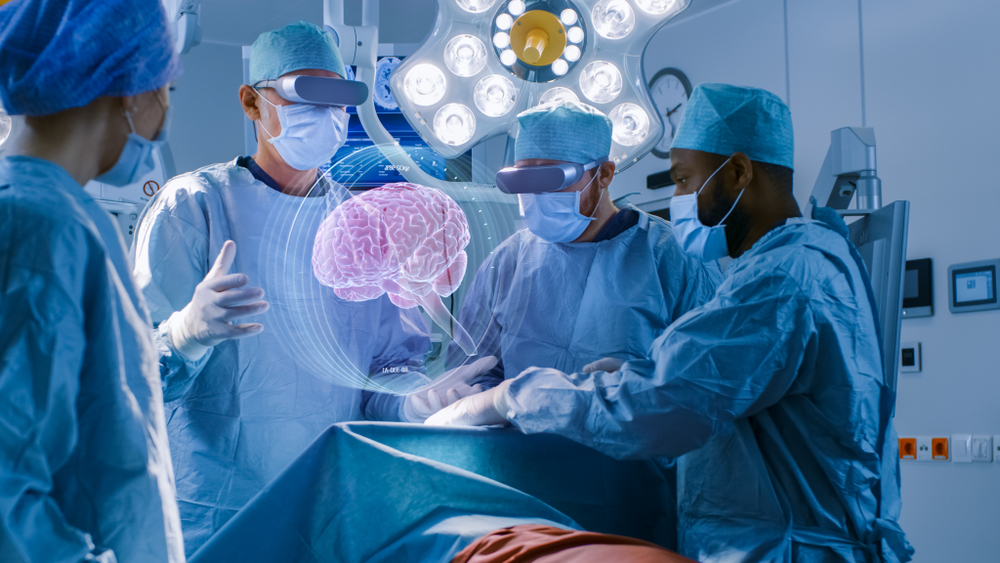Holograms: From Sci-Fi to the Science of Health

From training and diagnostics to patient management and surgery, find out how holographic technology could revolutionize healthcare.
From Back to the Future 2 and Star Wars to Iron Man and Blade Runner 2049, sci-fi has been fascinated with holograms. Discover how fiction is becoming a reality in the medical field, benefiting patients, practitioners, and the industry as a whole.
How holograms work
According to Interesting Engineering, “Holograms are virtual, three-dimensional images produced by the interference of light beams that reflect real physical objects. In simple words, holograms are 3D images formed when two light beams interfere and produce an image on a film or other surfaces.”
Light waves are made of electric and magnetic fields which can be deflected by passing them through a diffraction grating. “The finer the grating, the more the light wave is deflected. And we can combine a bunch of these diffraction gratings in order to shape a light wave however we want it to be shaped,” Benjamin Klein, former Associate Professor of Electrical and Computer Engineering at Georgia Tech, explains in this video.
Holograms and healthcare
Medical practitioners and students use imaging to learn the latest developments in their field, diagnose patients, and plan and execute the treatment. Medical holograms, which transform traditional 2D imaging into 3D, will give practitioners a better perspective and deeper understanding of their work.
Training future healthcare professionals
In the United Kingdom, extended reality company GigXR has partnered with Cambridge University Hospitals (CUH) and the University of Cambridge Faculty of Education. Through mixed reality technology, holographic patients are helping medical students enhance their training.
The training models, which include emergency scenarios and simulate deteriorating chronic conditions requiring hospitalization, enable students to make critical, real-time decisions and treatment choices–all without real-life consequences.
“Mixed reality not only allows us to create patient holograms that will have realistic medical responses to interventions, it also merges the latest advancements in hardware devices, software, remote capabilities, and expertise,” shared Dr. Arun Gupta, CUH consultant and Director of Postgraduate Education, Cambridge University Health Partners.
(Also read: Augmented and Virtual Reality Finds its Place in the Real World)
3D imaging through AI
X-rays, MRI scans, ultrasounds, and other flat medical images give doctors a limited perspective–leaving room for errors when detecting and identifying abnormalities.
In South Korea, researchers are using AI to transform 2D medical imaging into optimized 3D holograms that can be viewed without special glasses. Instead, the hologram follows the user’s eye movements. The hologram can also be scaled or rotated by the user’s hands or head.
"By incorporating artificial intelligence, the three-dimensional holographic display system recognizes the user's position and actions, and automatically synchronizes the contents,” explains Kang Min-gu, Senior Researcher at the Artificial Intelligence and Robotics Institute at KIST.
(Also read: AI in Medical Imaging: Revolutionizing Radiology)
Specialist care in remote locations
The COVID-19 pandemic accelerated technology adoption in healthcare, with social distancing and reduced face-to-face interaction pushing telehealth to the forefront.
In the remote islands of the Nagasaki Prefecture, mixed reality is enabling equal access to specialist care. In these islands, there are few specialists and an aging population. Patients with rheumatoid arthritis must travel to mainland hospitals to consult a specialist.
"We sometimes tried to use a wearable camera device to send images and sounds to a remote specialist," shares Dr. Fumiaki Nonaka, Assistant Professor of the Graduate School of Medical and Dental Medicine at Goto Central Hospital in Nagasaki Prefecture. "But it was hard for a specialist to see the affected area actively, and the patient could not communicate directly with a specialist.”
Remote specialist care using depth sensors and mixed reality technology is bridging the gap. Last 2021, Nagasaki University developed the Nagasaki University Rheumatoid Arthritis Remote Medical System (NURAS). It is the country’s first telemedicine system for rheumatoid arthritis treatment.
Three Azure Kinect DK devices encircle the remote patient and take simultaneous photographs of the patient’s hand. The image is transmitted in real-time to the specialist at Nagasaki University, who views the hologram with Microsoft HoloLens 2.
“When treating rheumatoid arthritis, accurate evaluation of joints is essential,” shares Shinya Kawashiri, a rheumatologist at the Nagasaki University Graduate School of Biomedical Sciences. “This system lets us evaluate the movement of joints in real-time. It gives specialists more realistic images of joints as if the patient were right there.”
(Also read: Telehealth: Logging on for Better Health)
Faster and more precise surgeries
Last January, surgeons from the National University Heart Center in Singapore successfully performed the country’s first holography-guided heart surgery.
Using Microsoft HoloLens 2, the surgical team was able to view a 3D hologram of the patient’s heart that they could rotate, resize, and superimpose onto the patient’s chest during the operation.
From pre-operation to surgery, the hologram helped the team anticipate difficulties and complications, select the optimum instruments for the procedure, and determine the least invasive approach to reduce trauma.
"The technology allows us to know the exact location and which angle to make the incision and cut the chest during operation, as well as provide a guide during the initial part of the surgery on whether the procedure is going to be a simple or challenging one," Associate Professor Theodoros Kofidis, head and senior consultant of the Department of Cardiac, Thoracic and Vascular Surgery in NUHCS, told The Straits Times.
As one of the Top 19 EMS companies in the world, IMI has over 40 years of experience in providing electronics manufacturing and technology solutions.
We are ready to support your business on a global scale.
Our proven technical expertise, worldwide reach, and vast experience in high-growth and emerging markets make us the ideal global manufacturing solutions partner.
Let's work together to build our future today.



![[HoloLens 2 / Azure Kinect DK / Azure AI]長崎大学 MR を活用した次世代オンライン遠隔医療システム | 日本マイクロソフト](/sites/default/files/inline-images/image%20%2845%29.png)


